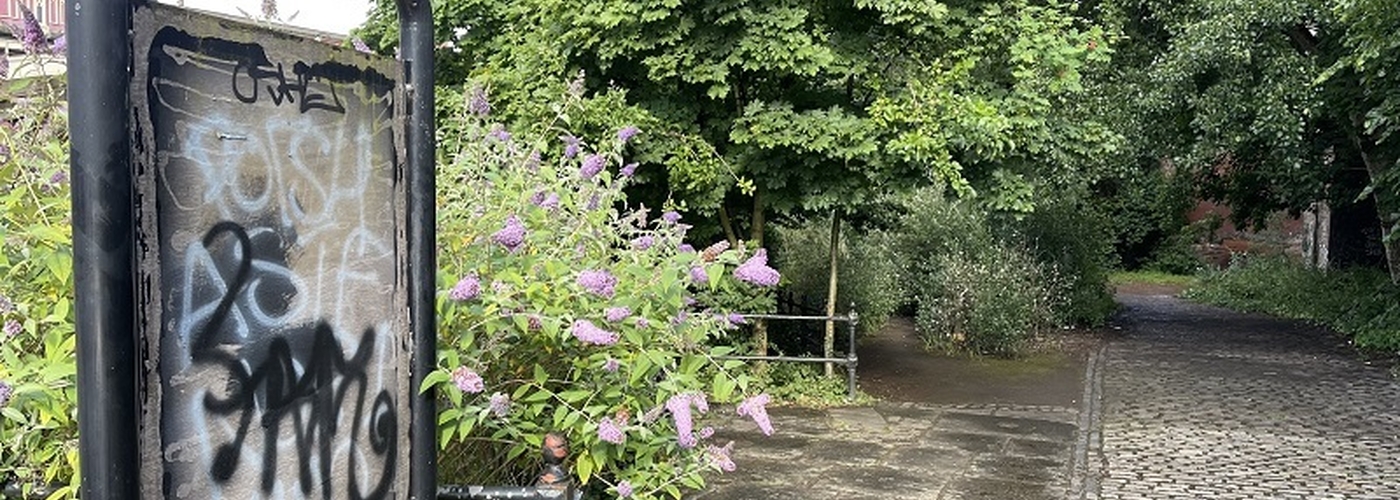Jonathan Schofield on the wasted opportunity that is Castlefield
Castlefield should be Manchester’s Albert Dock. It's very different in many ways, of course, to the Liverpool tourist magnet but it still should be the focus of a significant and fascinating collection of very old, medium old and very new assets set in a beautifully maintained public realm.
Pigeons have left enough guano the Council might think of selling it for profit
Unfortunately, Castlefield, aside from one privately owned area, is mainly an embarrassment. This despite it being signposted and talked about from all around the city centre and beyond as a jewel in our crown.
Let’s list the material assets of Castlefield. If managed correctly these would elevate it into one of the great urban British tourism destinations.
There’s the oldest passenger railway station in the world, the canal basin of the first true canal of the industrial age, reconstructions and remains of the Roman fort, spectacular soaring railway viaducts, fine canal bridges, canal warehouses, water, water, everywhere, old market halls, houseboats, bare sandstone rock faces, weavers’ cottages, a performance arena and room for lots of pocket gardens.
Then there's the currently refurbishing and huge asset of the Science and Industry Museum. Later this year (we hope) The Factory arts and performance centre will open with splendid public realm and we’ve just had good news about the Commercial Hotel.
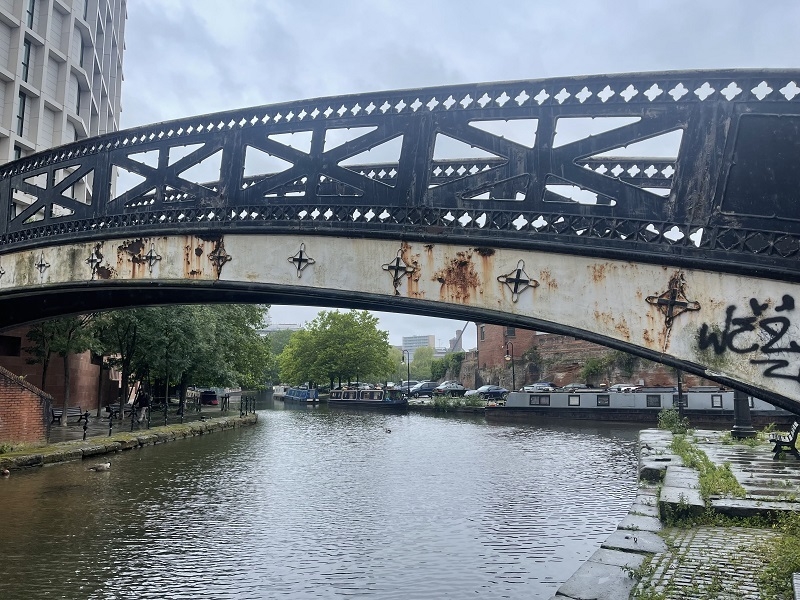
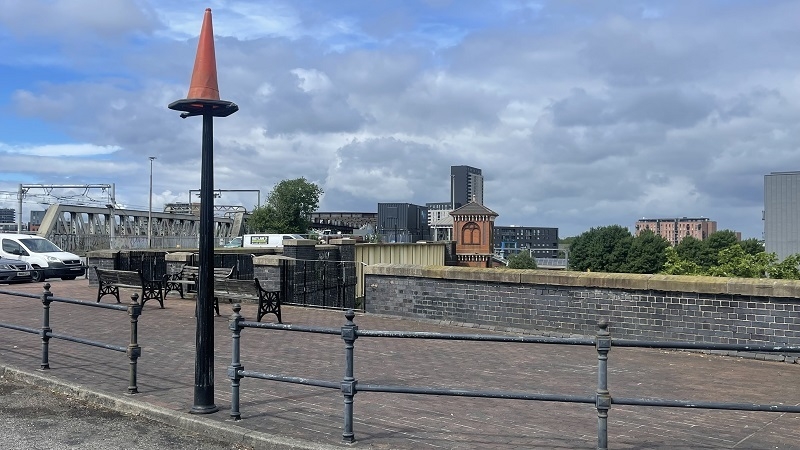
Now take a walk around the publicly-owned areas, and those owned by Peel Group, and it’s an embarrassment, despite some encouraging cosmetic bits and bobs in the last two weeks (which Confidentials has played its part in encouraging).
Where has it all gone wrong?
The public ownership lies principally in the hands of Manchester City Council and Transport for Greater Manchester (TfGM), private ownership problems lie with Peel Group. The blame lies with all these bodies.
Let’s describe the problems: would-be attractions are wrecked or uncared-for, particularly Grocer’s Warehouse and the reconstructed Roman fort north gatehouse, lawns are often uncut, beds untended, paving and steps largely unweeded, ornamental lamp-posts are decapitated, floodlights removed, signposts misleading and pointing the wrong way, history boards defaced, bins overflowing, ornamental bridges rusting away. The extremely useful lift between Manchester Central and the “Roman Gardens”, has been mothballed for years while just around the corner the stairs up to the National Trust’s pilot project garden on one of the Castlefield viaducts are a total mess.
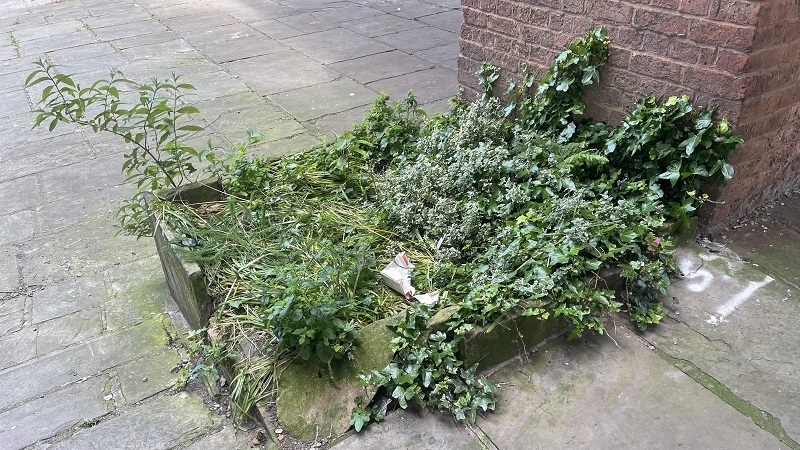
This is all a crying shame.
Afterall, so many Manc booster speeches we hear, from so many agencies in the city, from the Greater Manchester Mayor’s office, from the city council and elsewhere, name check our mighty industrial heritage and Manchester’s pioneering spirit, yet these are just empty words when you see the decrepitude of places such as Grocers Warehouse, the abandonment of Pioneer Quay and the simple lack of care about so much in Castlefield. It’s all blah blah blah when we treat a vital spring point for the global Industrial Revolution with such carelessness. Clearly people repeat the words without walking the reality.
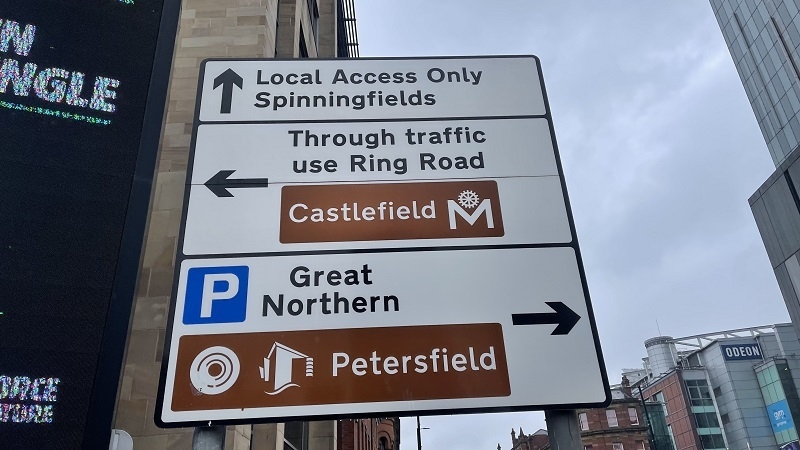
It's not just the public realm as well. What on earth is going on with the areas defining features, the viaducts, or rather what's going on with what lies beneath them and between them?
The fine National Trust work aside, there’s the dreadful surface and railway arch car parks along Bridgewater Street and Collier Street let by publicly-owned TfGM to SIP, a particularly nasty, aggressive and unaccountable, private car parking operation. SIP apparently stands for Simple Intelligent Parking, not and this might be a surprise, Sinister Inscrutable Predators.
We asked TfGM how much they, as a public body, were receiving in rents and fees from the Sinister Inscrutable Predators and they said that was “commercially confidential to TfGM.” We pressed them and they said: “The occupier, contractual details would not be provided (even) under a Freedom of Information Act request”.
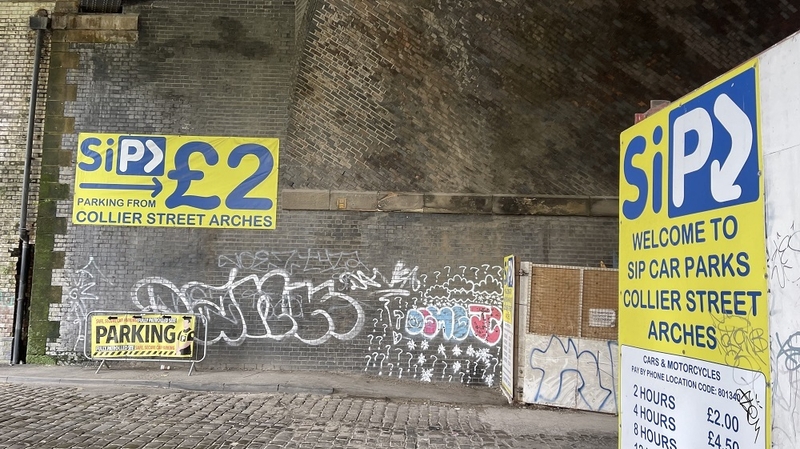
Collier Street leads to the Collier Street Arches car park run by SIP which leads to a genuine scheduled ancient monument, part of the east wall of the Roman fort.
Go in and try and find it. Difficult that. It’s hidden behind an evil-looking fence swamped by buddleia under the cover of a railway arch. I have the 1883 tome titled Roman Lancashire by W Thompson Watkin (of course I have) and in it, Watkin points out how the railway company surveyed the viaduct here so it leapt that last genuine Roman vestige and how Lord Francis Egerton “had its protection secured by a legal document”. It’s massively protected now. It’s fenced off. Nobody can find it. That will keep it safe.
Egerton became the Earl of Ellesmere who built Worsley New Hall which was eventually demolished. The former gardens have now blossomed into RHS Bridgewater.
That’s what's missing here.
Castlefield should be an intensely urban RHS Bridgewater. Spectacularly so, because it would be different from anywhere else in the UK.
Back in 2007 Confidentials proposed that all the separate parcels of land, magically divided by the inspiring leap of viaducts and the wash of canals, should be turned into exactly that. We’ve lost the damned archive but back then we photoshopped herbaceous borders against railway walls and manicured lawns (yep manicured not "re-wilded") to create what could be an urban RHS. It looked splendid.
Not that you have to walk far to see what can be done in Castlefield’s publicly owned areas if energies are harnessed and efforts coordinated. Castlefield has a core area south of the railway viaducts owned by Castlefield Estates consisting of Dukes 92, Albert’s Shed, the Lockkeepers Cottage, Merchants Warehouse and Bass Warehouse. The areas around this substantial estate is immaculately maintained. It’s a model for the standard required in the other areas north of the viaducts and at Grocer’s Warehouse and Pioneer Quay off Deansgate.
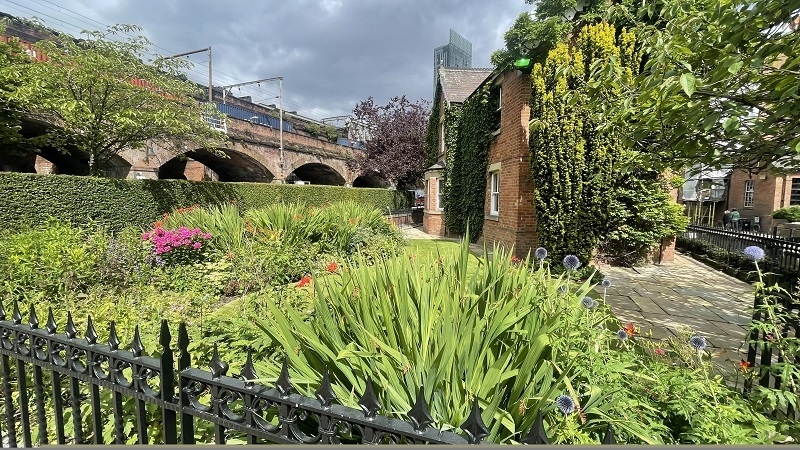
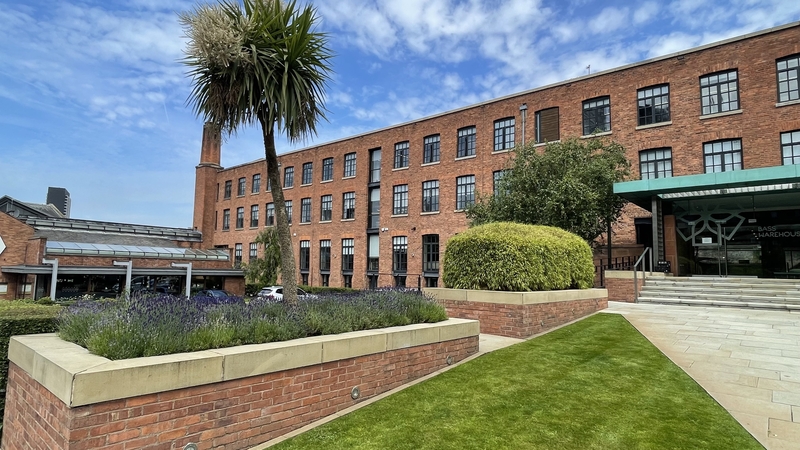
There is also an active residents and businesses group involved in Castlefield as well, the Castlefield Forum, which coalesced following those Manchester Confidential articles a decade and a half ago. What does the Forum think with regards to the maintenance and improvement of this precious part of the city in its publicly owned and Peel Group owned areas?
We got this reply.
“Castlefield Forum is run entirely by volunteers, many of whom also work or have other commitments and yet still we get plenty done. It shouldn’t be down to us to chase the owners of land or assets in Castlefield when issues arise and indeed, we could better spend our time on more pressing projects. For example, it shouldn’t fall to a charitable neighbourhood organisation to continually raise tickets on the Council’s website about parts of Castlefield to inspire action be taken.
“Engagement with Manchester City Council has improved in recent months and we strongly encourage those with responsibilities for places and spaces in our community to take more pride - and a more proactive approach - in their upkeep."
Pride. And opportunity.
The point here is the National Trust is bringing a £2m park project to Castlefield’s first floor. This is, was, or should have been the big opportunity, to get the public areas up to scratch, fix the lift, sort the stairs, mow, clip, weed, put the heads back on to those lights, sort out the history boards, start work on Grocers Warehouse and so on.
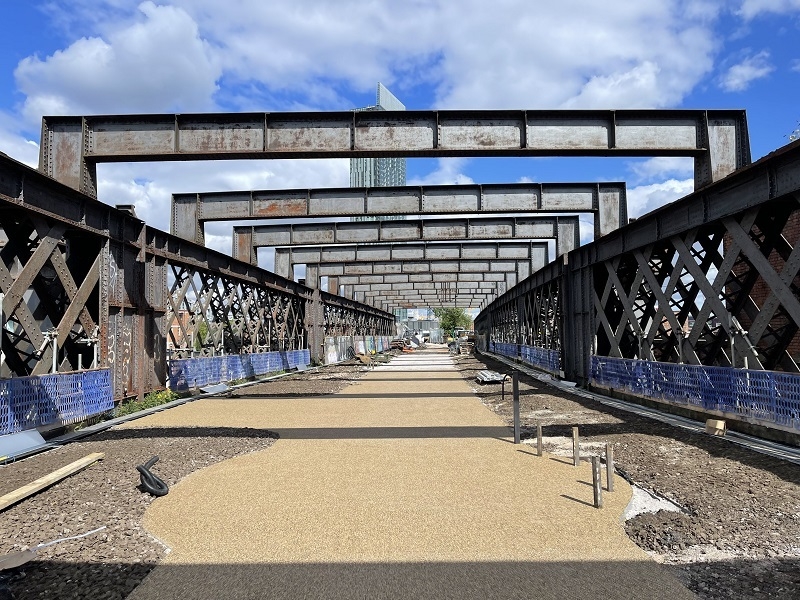
A case study in idiocy: the Castlefield iron stairs
TfGM told us it was “looking into” the very important stairs access to the National Trust’s viaduct. They own the stairs and they have looked into them and they have delivered a right mess. When we pointed this out, we got a response a couple of days before the publication of this article saying that although TfGM owns the stairs they are maintained (ha, when in the last 15 years?) by Keolis Amey Metrolink which operates the Metrolink system. So, obviously, sometime after our original questions KeolisAmey Metrolink had been prodded by TfGM into action.
I imagine some boss of Keolis Amey Metrolink saying: “Hey, we’re getting a bit of pressure about some stairs in some place called Castlefield. Do you remember those old paint pots in the back of the depot, grab some, and take a cherry-picker down there and slap up some paint in our livery would you?”
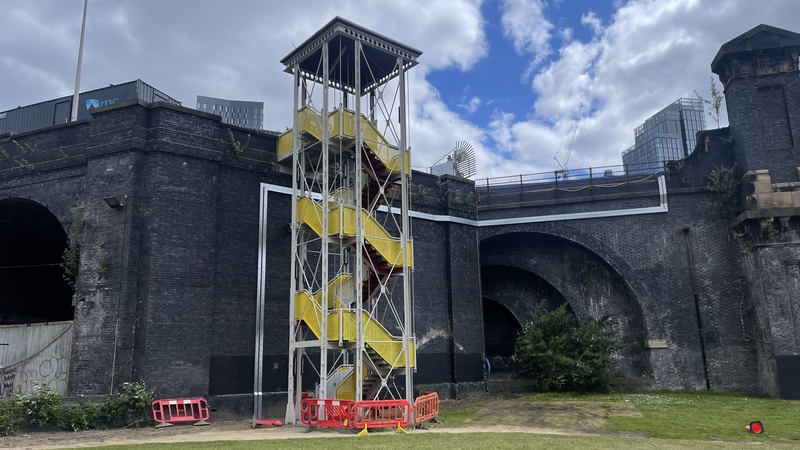
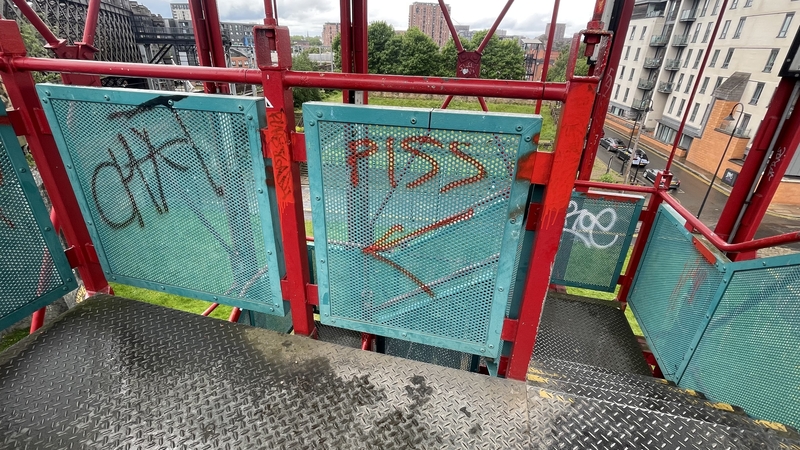
It must have been that scenario because the work is so slapdash. The original colour scheme of the stairs was bad enough in the flaking teal of the first Metrolink branding with some superfluous red paint included. The new paint job has been hurriedly daubed over algae meaning it will probably peel rapidly while there are drips everywhere and the old teal colour still shows through the gaudy yellow and death-shade grey reflecting the current Metrolink branding. The result is that it all looks unfinished. Perhaps it is, and it's just been abandoned. The grey looks like primer, the yellow looks like jaundice.
It gets worse. You look at the lawned areas under the stairs where the cherry-picker was posted. The grass has been destroyed and rutted. So, in support of the National Trust’s good work in making Manchester city centre more attractive and with total disregard for the Roman Gardens and the heritage of this nationally important area TfGM have allowed the operator of Metrolink to make things worse.
What was that Castlefield Forum was saying about “pride”?
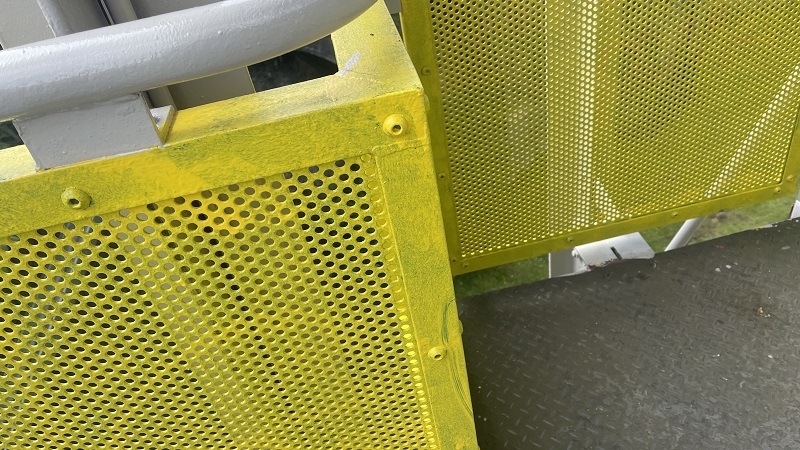
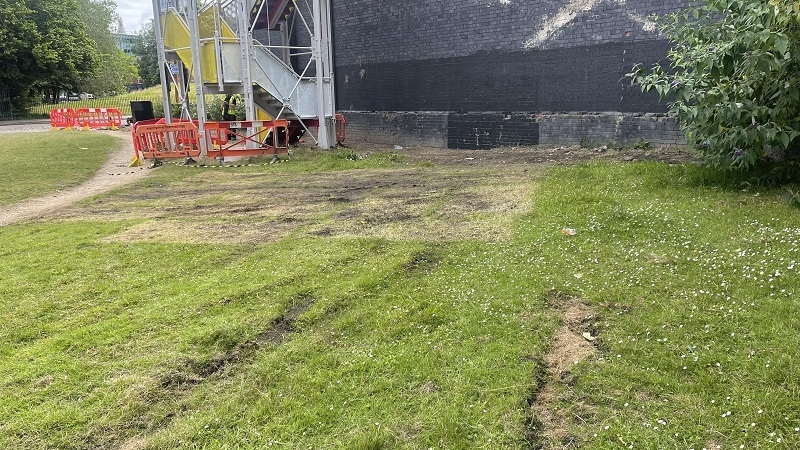
A case study in neglect: Grocer’s Warehouse and Pioneer Quay
At the eastern end of the Castlefield site, one of the more fascinating parts of this significant area is the lower and upper levels of Grocer’s Warehouse, owned by Manchester City Council. This is a building where waterwheels and pulleys hauled coal coming from the mines at Worsley on the Bridgewater Canal up to the road level for distribution around the city. There were remedial and reconstruction works conducted in the 1980s to show the cunning way this was done. Visits inside the building allowed this to be demonstrated.
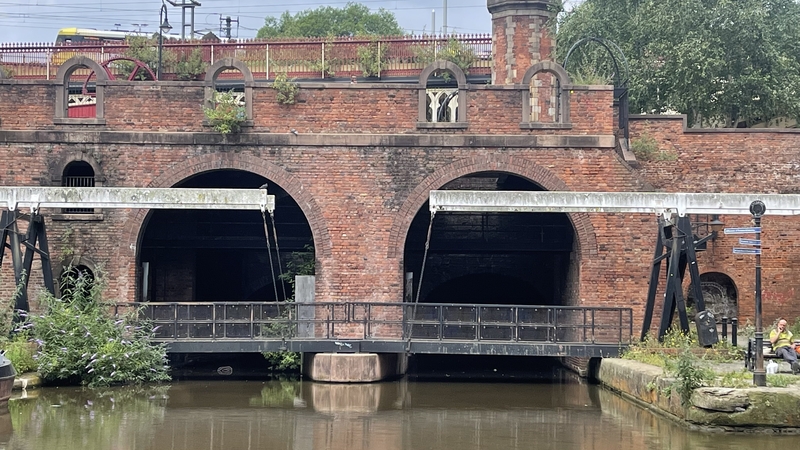
In 2022 the timber in the building is rotten, Grocer's Warehouse is a wreck, access is denied, where the boats would offload the water is filled with traffic cones and other detritus that has been there for years. Pigeons have left enough guano the Council might think of selling it for profit.
The potentially lovely adjacent area is overgrown with weeds, cobbles torn up, bins usually overflowing, litter everywhere, the area defaced by graffiti and the stairs between the levels frankly dangerous. Yet Grocer’s Warehouse is signposted from other areas and has a history board attached to it as though it’s worth visiting.
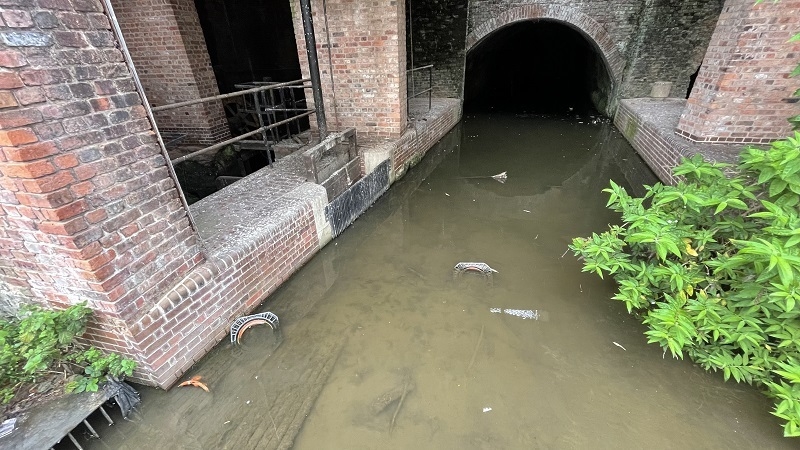
So what do Manchester City Council say? Well, apparently, “scheduled health and safety works on Grocer’s Warehouse will be undertaken shortly, rotting timbers will be replaced and the internal elevation structure will be secured and made safe. This will then enable a principal survey to be undertaken of the building. Grocer's Warehouse (is) included in a capital programme for improvement that will be delivered within the next five years, alongside regular maintenance.”
Confidentials asked: What does “shortly” mean? We were assured it would happen by 8 July. Nothing has happened that we can see. But for the major refurb to not take place for potentially five years seems very long given its dreadful state presently. Full restitution of the Roman fort north gate has also a "within five years" timescale.
Yet, not all the problems here lie with the Council. The adjacent footbridge is owned by Peel Group and has been around since the eighties too. The intention back then was to give the area a sort of Venice-with-industry feel and the bridge was painted a crisp white. It’s a rusty dirty disgrace now, and dangerous to cross in wet weather it's so slippery. The other Peel-owned bridges in Castlefield are either rusty, dirty or both. Clearly, the vast resources of Peel are directed elsewhere, directed away from that notion of “pride” in Castlefield's landscape.
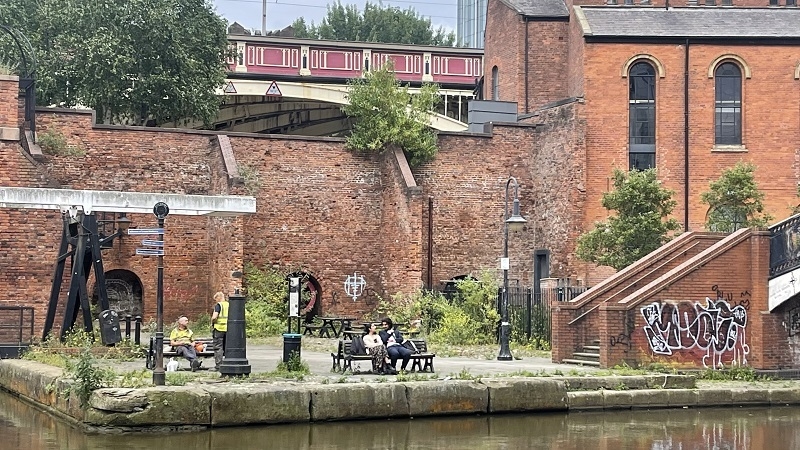
Meanwhile, over the road and across the Rochdale Canal, is Pioneer Quay. This is potentially a perfect area for a public garden between dramatic viaducts and the waters of the Rochdale Canal. The canal arm that edges the western end is choked with waste and rubbish while the rest of the site is filthy, overgrown and litter-strewn. There’s a rough sleeper camp under one arch and so some of the waste down there goes beyond abandoned packaging.
TfGM owns Pioneer Quay but there’s nothing pioneering about their reply to our questions. Something will happen sometime they say: “(Pioneer Quay) forms part of the Castlefield Quay redevelopment scheme and is one of a number of TfGM-owned parcels of land in this area which will be used for development/regeneration. We are working with a development partner at the moment to look at possible development options.”
Please get on with it then. This is a city centre site next to the main route from the south west over from a well-used canal path to the centre of Castlefield and the good work Castlefield Estates provides.
By the way, the general maintenance from Manchester City Council in their areas is to mow the grass every two weeks and the difficult bits, down those Roman ditches and up those Roman banks, every month. Elsewhere a man with a strimmer strims, which is not gardening as such, or if it is it’s brutalised gardening

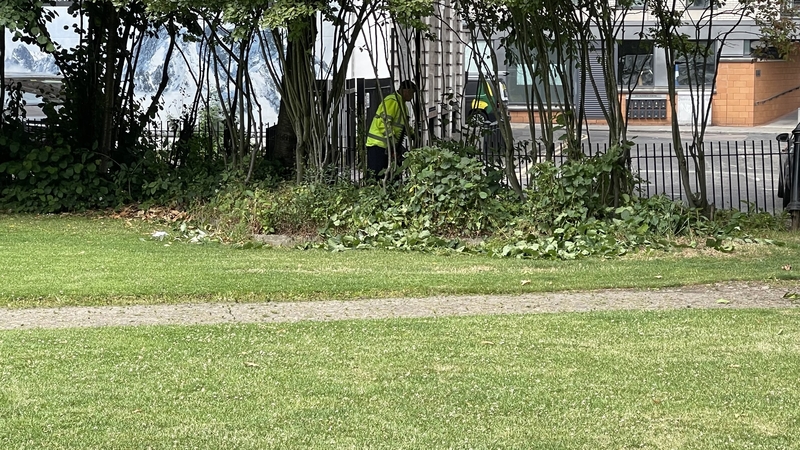
So where do we go from here?
Let’s dream dreams. Let’s imagine those empty railway arches filled with independent retailers or bars and restaurants, places as interesting as the marvellous Saul Hay Gallery. Let's have diverse events away from the current predictable programme of gigs. Let's have something more like Jeremy Shine's Castlefield Follies coming up at the end of the month. Let’s imagine all the gaps between the viaducts and buildings blossoming as gardens and the green areas we have following suit.
Cloud cuckoo land, no?
No, it isn’t. Already in Castlefield, we have the example of Castlefield Estate as a model. But what about a different way? What about the method of beautifying Didsbury in Parsonage Gardens, an area not dissimilar in size to the Roman Gardens in Castlefield? What about the utterly lovely work at Ordsall Hall in Salford, a short mile away? That splendid garden is run by one paid professional, aptly called Jo Green, and volunteers.
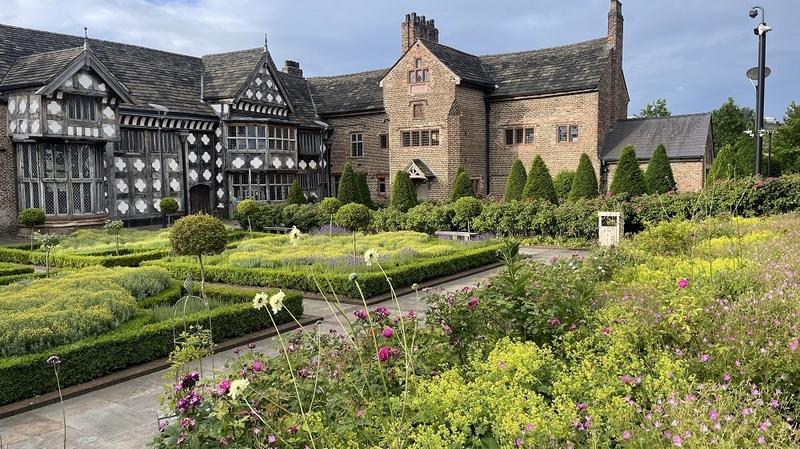
Heather Stemp, Chair of Friends Fletcher Moss and Parsonage Gardens in Didsbury, explains how it works down there.
“Manchester City Council still own Parsonage Gardens but we do all the work there, all the gardening, the council does none. We have about 37 volunteers on the books and every Tuesday we get 24 or 26 along. It becomes a social occasion when we meet, there are cakes and refreshments. It creates a sense of belonging and also makes people feel a real part of the community taking responsibility for making the place where we live better.
“The Council don’t have the resources to do this work anymore. Before us, the council had contracted out the gardening and the company they employed just periodically slashed everything back and Parsonage Gardens got into a terrible state. Now we are a completely self-funded volunteer organisation and provide everything including equipment.
“The council does give us, and some of the other 400 similar volunteer city groups, bedding plants through a competition run by the RHS. We also apply for NIF grants (Neighbourhood Improvement Grant), which is money set aside by the city for each ward. We have fund-raising events too. We’re very proud of our work.”
Heather and her team should be. What they have delivered is wonderful.
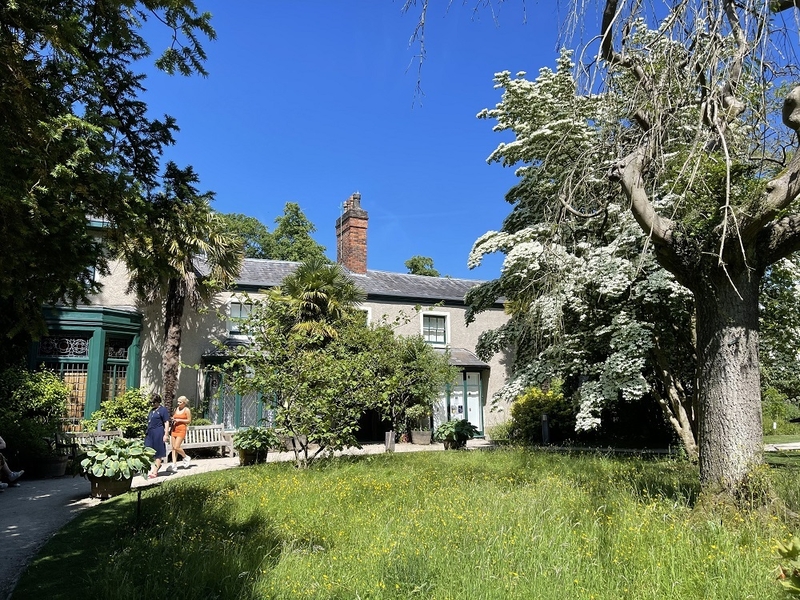
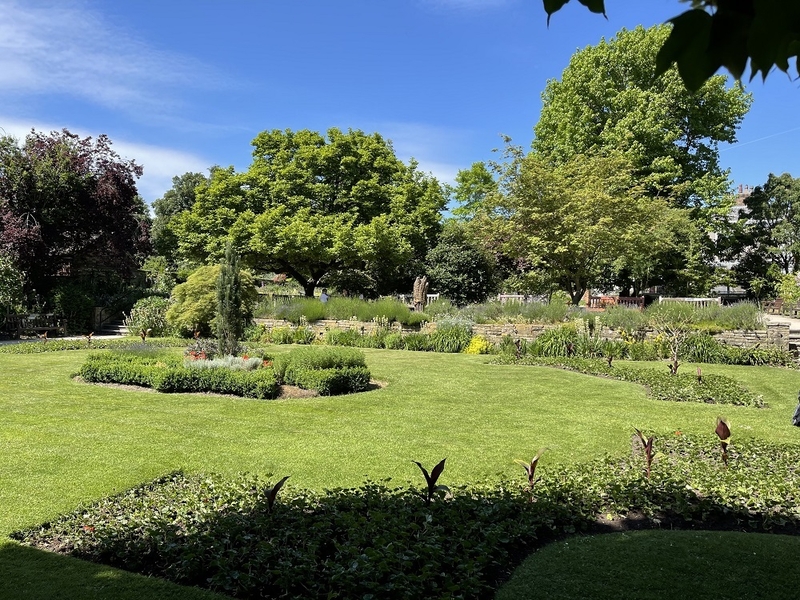
So why not have the same arrangement for the already green, if poorly maintained, public areas of Castlefield? Yes, the city centre has a far more transitory population, yes it isn't a cosy suburb, but why should this be a barrier? People don't tend to have gardens in the city centre, this could be their gardening downtime.
Heather Stemp tells Confidentials she would give advice so why not take the maintenance of the lawns, borders and beds out of the City Council's hands and give it to the locals, perhaps through Castlefield Forum? This would be better and cheaper for the City Council and better for the maintenance and appearance of Castlefield.
This would solve one problem but not the issue with capital projects, of course.

A coordinated approach?
Capital projects such as the maintenance and repair of the Castlefield lift, repair of lighting, refurbishment of Grocer's Warehouse and the existing Roman fort reconstructions would have to be still undertaken by the Council and TfGM of course.
In some respects, the minimum maintenance provided by the Council at present is understandable if not necessarily excusable given what Castlefield could and should be. The Council's budget has been slashed by successive governments. Most of what councils do in 2022 in the UK is all about being a branch of the welfare state, they don't have much bandwidth left to worry about places such as Castlefield.
The problem with the TfGM property is more intractable. They are a body that coordinates transport infrastructure, they are not a property specialist, or at least don't appear to be. The total farce of that repainting of those important stairs between the levels is a case in point.
There is a clear way forward here. It would be for all the public organisations with a stake in Castlefield; Manchester City Council, TfGM, KeolisAmey Metrolink, Manchester Central, and the waterways authorities to get together and come up with a single coherent strategy for this immensely valuable landscape. It needs officers in any future coordinated agency to understand the value of Castlefield, not bean counters who are ignorant of the city's heritage and care little for it. Peel Group and Castlefield Estates should be part of the conversation in that coordinated body. Castlefield Forum must be represented.
We know the city centre councillors are encouraging action to be taken in Castlefield which has paid off with a promise by the City Council to repair to lift that would bring people right up to the National Trust project. That is a slight gain but one that might only be temporary without a collective effort. And when will those ornamental lights be fixed, the bins regularly cleaned, basic maintenance delivered and so on? To wait up to five years for Grocer's Warehouse to be refurbished is too long.
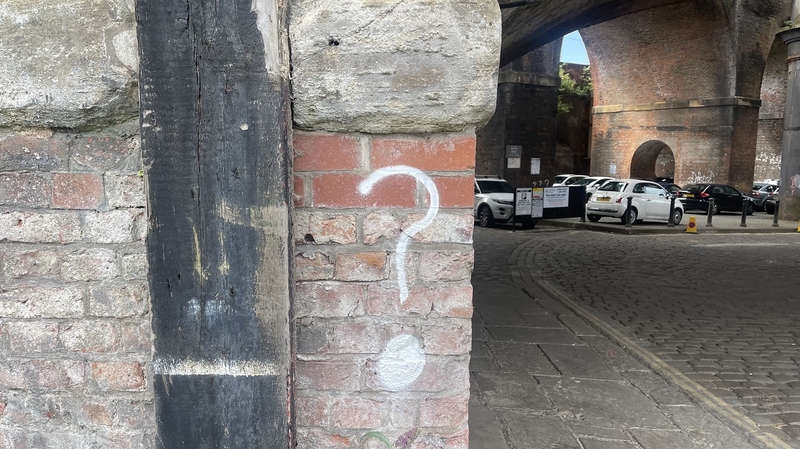
Why does any of this matter?
The state of Castlefield matters because a superior Castlefield would add to the city and region’s economy, it would be something we could promote with confidence, not with trepidation. It would bring in cash to the economy, be something to sell.
It would be the link between the assets of Factory, when it opens, the Science and industry Museum, after refurbishment, and with the wider city linking east with Deansgate Square and First Street and north to Spinningfields. It would support the Viaduct garden being delivered by the National Trust if the two-year pilot project works out.
Further, at a time when no company or governmental agency can go seven minutes without repeating the mantra of "wellbeing", this would deliver a practical city centre moment of real, not virtue-signalled, wellbeing as people walk around a lovely series of pocket parks made unique in the country by being scattered between the hard bones of industry and enlivened by the sparkle of canal waters.
We know beautiful places make people feel better about themselves and their world whether they are Mancunians or visitors spending money. Castlefield is ripe and ready to be beautiful. In the end, it's just a matter of effort and imagination to make that happen.
And finally why not?
Why not make Castlefield an exemplary urban area mixing old and new, the floral and the green? If Manchester, uniquely, has a place in its city centre where the oldest industrial canal meets the first canal to cross the Pennines, where the oldest passenger railway station sits in a mighty museum round the corner from a brand new arts centre, where the Roman origins of the city sit under a spectacular set of viaducts, then why the hell is the city not exploiting this incredible urban landscape to its maximum?
I took a group of National Trust people around recently and one female guest said: "This is such an impressive area. I had no idea how, well, how physically exciting this urban landscape is."
Quite. Surely, it's time to fully exploit the potential of Castlefield.
Follow Jonathan Schofield on Twitter @jonathschofield
You can book a Jonathan Schofield tour here or by one of his books here.
Read next: Castlefield Viaduct: What to expect from landmark green space
Read again: 'Tech hub space' to replace Manchester's Air & Space Gallery
Get the latest news to your inbox
Get the latest food & drink news and exclusive offers by email by signing up to our mailing list. This is one of the ways that Confidentials remains free to our readers and by signing up you help support our high quality, impartial and knowledgable writers. Thank you!






